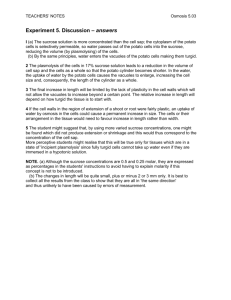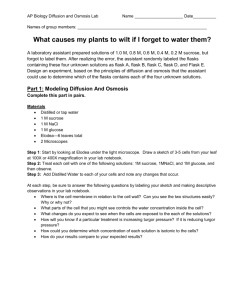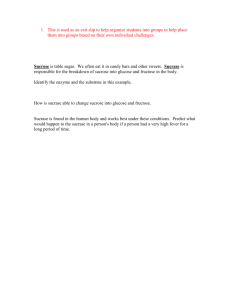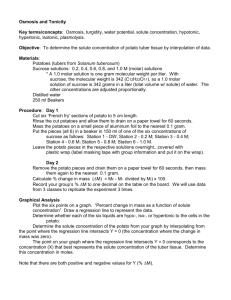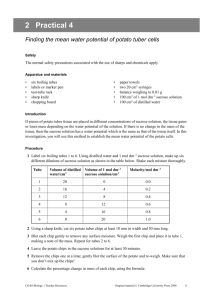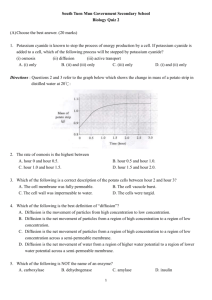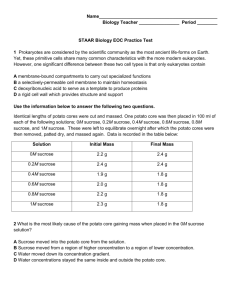Standard Grade Biology – Investigating Cells Revision
advertisement
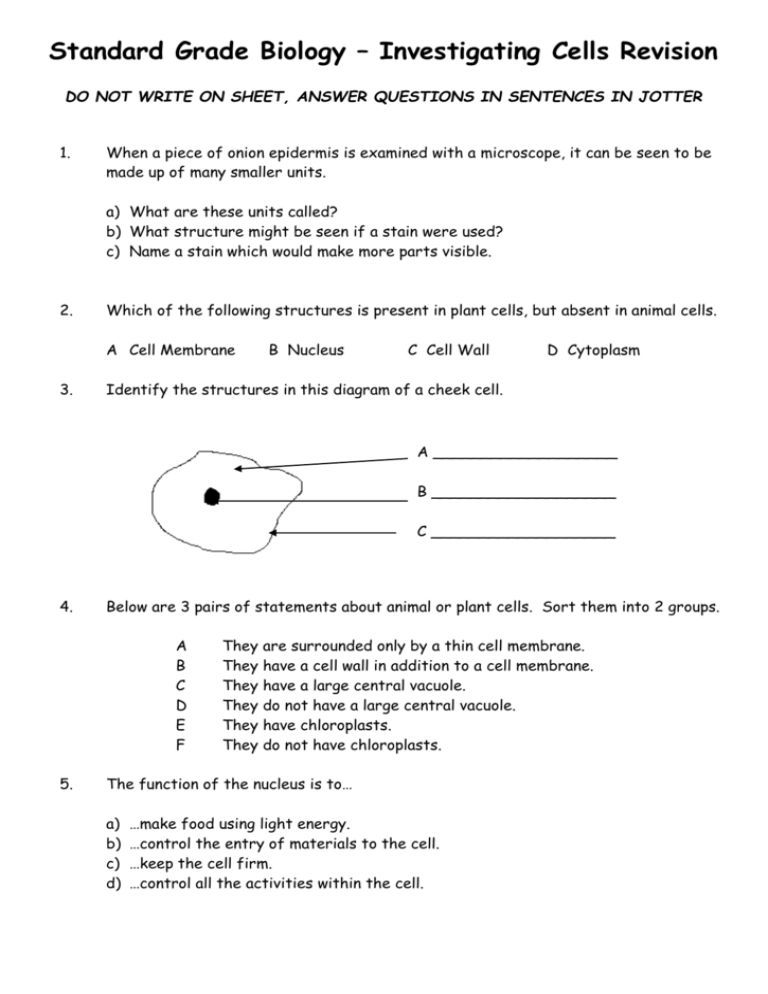
Standard Grade Biology – Investigating Cells Revision DO NOT WRITE ON SHEET, ANSWER QUESTIONS IN SENTENCES IN JOTTER 1. When a piece of onion epidermis is examined with a microscope, it can be seen to be made up of many smaller units. a) What are these units called? b) What structure might be seen if a stain were used? c) Name a stain which would make more parts visible. 2. Which of the following structures is present in plant cells, but absent in animal cells. A Cell Membrane 3. B Nucleus C Cell Wall D Cytoplasm Identify the structures in this diagram of a cheek cell. A ___________________ B ___________________ C ___________________ 4. Below are 3 pairs of statements about animal or plant cells. Sort them into 2 groups. A B C D E F 5. They are surrounded only by a thin cell membrane. They have a cell wall in addition to a cell membrane. They have a large central vacuole. They do not have a large central vacuole. They have chloroplasts. They do not have chloroplasts. The function of the nucleus is to… a) b) c) d) …make food using light energy. …control the entry of materials to the cell. …keep the cell firm. …control all the activities within the cell. 6. The diagram below shows the effect of placing a plant cell in a concentrated sugar solution. a) Explain the change in appearance of the plant cell. b) What term is used to describe the resulting appearance of the cell? 7. Four pieces of potato, of the same mass, were placed in 4 beakers of solution as shown. After 2 days, which piece of potato was heaviest? A Air 8. C 5% Sucrose D 20% Sucrose Explain this in terms of movement of water molecules. The optimum temperature for an enzyme is… a) b) c) d) 9. B Distilled Water …the …the …the …the lowest temperature at which it works. highest temperature at which it works. temperature at which it works best. temperature at which it stops working. Complete the following sentence. Osmosis is the movement of ________ from a region of _______ concentration of water, to a region of ____ concentration of _________ through a ________ __________ membrane. 10. Choose the correct word to complete the sentence. Oxygen diffuses from a (high/low) oxygen concentration to a (higher/lower) oxygent concentration. 11. Give examples of 3 substances which can enter or leave a cell by diffusion. 12. Explain how molecules of a substance such as glucose into a cell. Use the terms “low concentration” and “high concentration”. 13. When red blood cells are placed in distilled water… a) b) c) d) 14. A plant cell will not burst when placed in water because it has a… a) b) c) d) 15. …the water will move into the cell and it will burst. …water will neither move in or out and the cell will stay the same. …water will move out and the cell will shrink. …some water will enter the cell and it will swell up. … cell membrane. …nucleus. …cell wall. …vacuole. The apparatus shown was used to investigate osmosis in potato cells. Beaker Cylinder of potato The potato cylinder was weighed before, and again 30 minutes after being placed in the strong sucrose solution. Strong sucrose solution a) Explain what would happen to the mass of the cylinder during the 30 minutes . b) The change in mass was due to… 1) …sucrose moving into the cells. 2) …water moving out of the cells. 3) …sucrose moving out of the cells. 4) …water moving into the cells. c) Describe the appearance of the potato cells after 30 minutes in the strong sucrose solution. 16. Which of the substances in the following reaction is the substrate. STARCH Amylase GLUCOSE 17. Name 2 essential processes which take place inside cells, which involve enzymes. 18. Explain the term specific when used in connection with enzymes. 19. Enzymes are found in… a) …some living cells c) …all living cells 20. b) … most living cells d) …only dead cells. Choose one word from each group to make the following sentence correct. Enzymes are (carbohydrate/fat/protein) molecules present in (all/some/most) living cells where they (speed up/slow down/stop) chemical reactions. 21. Copy and complete the following table, which refers to the activities of 3 enzymes. ENZYME SUBSTRATE Phosphorylase Glucose-1-phosphate Amylase Hydrogen Peroxide 22. PRODUCT Glucose/Maltose Water + Oxygen The apparatus shown was used by a pupil to investigate the action of an enzyme on starch. A B C a) Identify enzyme X. b) Explain what change would take place in the contents of test tube A during the experiment. c) Describe a test you could use to see if the experiment has been successful. Starch solution + Enzyme X 23. What is a control? Give an example. Starch solution + Water Enzyme X + Water
